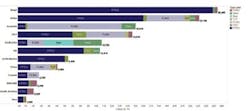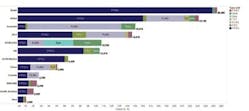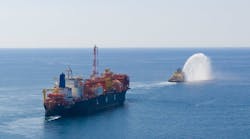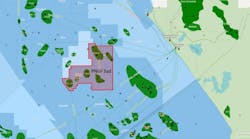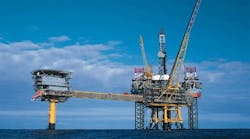Charts courtesy Energy Maritime Associates Pte. Ltd.
David Boggs
Energy Maritime Associates Pte. Ltd.
Through the end of the decade, the largest markets for floating production systems are expected to remain in Brazil, West Africa, and Southeast Asia. However, there are new areas of growth, particularly in East Africa and the Mexican portion of the Gulf of Mexico.
The fastest growing segment is forecast to be gas processing units, namely FLNGs and FSRUs, which are expected to account for 25% of all floating production systems capex over the next five years.
However, oil processing units, especially FPSOs, will continue to be the dominant type of floating production systems worldwide. FPSOs are expected to account for 45% of the projected orders and 60% of the capex. Floating production systems are defined here to include FLNGs, FPSOs, FSOs, FSRUs, semisubmersibles, spars, and TLPs.
Five-year forecast
Between 105 to 188 floating production systems are expected to be built over the next five years with a total capital cost between $80.2 and $157.4 billion. The most likely forecast is 142 orders costing $118.5 billion. Units for Brazil and Africa will account for $48 billion of expenditure, followed by $30 billion in Australia and Southeast Asia, and over $25 billion in the Gulf of Mexico and Northern Europe. Significant growth is expected toward the end of the decade in Mexico as international companies enter the market.
Brazil and Africa should continue to attract the most capital investment over the next five years. Over $25 billion is the best case estimate for Brazil, driven by FPSOs for Petrobras. Africa is a close second with $23 billion of spending mainly on FPSO and FLNG projects. Approximately $15 billion will be spent in floater projects in Australia and Southeast Asia. Australia investments are dominated by large gas FLNGs and semis, while Southeast Asia has a mix of FPSOs, FLNGs, and FSOs. Projects for the US GoM and Europe are expected to cost around $10 billion, mostly on FPSOs in the North Sea. Units for the US GoM are spread amongst FPSOs, FLNG export terminals, spars, and production semis. A new growth area for the next five years is the Mexican side of the GoM, where $6.4 billion is expected to be spent on FPSOs and FSOs.
Brazil
FPSOs will account for almost all of the new units expected over the next five years in Brazil. Most, but not all, will be for Petrobras. The Brazilian state-owned company had planned to award at least 14 new floating production contracts over the next three years. However, this is unlikely to happen on schedule given the investigations and financial issues surrounding the company. There will be a delay in these awards, so we do not expect to see many contracts placed by Petrobras in 2015. However, the presalt fields have proven to be viable and additional FPSOs will be required for development. According to Petrobras and its partner BG, the break-even for many of these fields is $45/bbl.
Two non-Petrobras projects that could require FPSOs include Phase 2 of Queiroz Galvao's heavy-oil Atlanta development in block BS-4 and Karoon's Kangaroo discovery. In December 2014, Teekay was awarded a three + two year lease contract to redeploy the Petrojarl 1 FPSO for Phase 1 development of the Atlanta field. A larger FPSO with up to 80,000 b/d processing capacity could be required for the full field development. A redeployed FPSO could also be a viable solution for the Kangaroo field.
Africa
The vast majority of projects in Africa will continue to be located on the west coast, particularly off Angola and Nigeria. However, floating production units are also being used in new areas. Ghana received its first FPSO for Tullow's Jubilee field in 2010. Tullow selected Modec to provide another FPSO for the nearby TEN development, which is scheduled to begin production in 2016. In January 2015, Yinson was awarded a 15-year FPSO lease contract by Eni for its Sankofa/Gye Nyame development. Potential new projects in Ghana include an FPSO for the ultra-deepwater Tano Cape Three Points field and an FSRU as part of a natural gas-fired power plant development.
There are no floating production units in operation or on order for East Africa, but this is set to change with seven projects currently being planned. All of these are natural gas developments – three off Mozambique, three off Tanzania, and one off Kenya. BG is investigating use of multiple TLP units for its deepwater fields in Tanzania's block 1 (Mzia and Jodari) and block 4 (Pweza, Chewa, Ngisi). In Mozambique, a front-end engineering and design (FEED) competition is in progress for an FLNG unit to develop Eni's Coral gas fields in Area 4. In order to achieve first production by 2019, an award would be required in 2015. After Coral, Eni has plans for two additional FLNG units and an onshore plant to monetize Area 4's Mamba discoveries. An FSRU could be required as part of Kenya's Dongo Kundu power project.
Displaying 1/2 Page 1,2Next>
View Article as Single page
